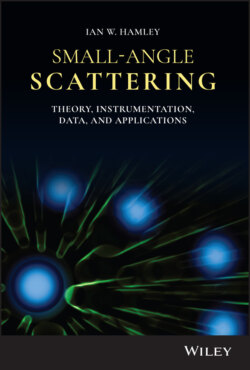Читать книгу Small-Angle Scattering - Ian W. Hamley - Страница 27
1.7.3 Factoring Scattering from the Particle Cross‐Section
ОглавлениеFor a long cylindrical particle the scattering intensity (form factor) can be computed from Eq. (1.6) by calculating the average exp[−iq.r] in polar coordinates (l, z, γ), where the q vector and vector r to a point in the cylinder are related by the polar angles (ϕ, γ) (Figure 1.18):
(1.87)
Figure 1.18 Inter‐relationship between vectors q and r in cylindrical co‐ordinates.
For a uniform cylinder (radius R, length L) this leads to the expression [57]
(1.88)
(1.89)
Performing the integral over z (using the same formula as in Eq. (1.12)) we have
(1.90)
For L > > R we can factor this as the product of intensity associated with the length of the particle IL(q) and that of the cross‐section Ic(q) (i.e. the intensity is written as a convolution product):
(1.91)
where
(1.92)
The integral over ϕ extends to infinity to make use of the Dirichlet integral, this is valid when q ≥ 2π/L, since the integrand is negligibly small for x > 1 [7]. This leads to the factorization [5, 6]
(1.93)
where Ic(q) is the form factor of the cross‐section. As mentioned above, this is valid when L > > R. Eq. (1.93) shows the I(q) ∼ q−1 scaling for a cylindrical particle at low q (where IL(q) dominates). This derivation is for a uniform cylinder for which Ic(q) can be evaluated as in the following, however Eq. (1.93) applies in general for other rod‐like particles.
The cross‐section intensity is related to the distance distribution function of the cross‐section, γc(r), via the expression [6, 7]
(1.94)
Here D is the cross‐section diameter. For a uniform cylinder this may be evaluated to give [6]
(1.95)
In these equations J0(qR) and J1(qR) denote Bessel functions of integral order. The cross‐section radius is given by [58] (see also the discussion in Section 1.4).
The pair distribution function of the cross‐section can be obtained from the cross‐section intensity via an inverse Hankel transform [7]
(1.96)
For flat particles (discs of area A) the intensity can be factored, via an equation analogous to Eq. (1.93) as [4, 6, 10]
(1.97)
where It(q) is the cross‐section scattering that depends on the thickness T, which is related to the cross‐section radius via [58].
Expressions (1.93) and (1.97) indicate that as an alternative to the Guinier equation which provides Rg, the cylinder cross‐section radius can be obtained from a plot of ln[qI(q)] vs. q2 and for discs/planar structures Rc can be obtained a plot of ln[q2I(q)] vs. q2 [58, 59].
If the intensity is measured on an absolute scale it is possible to determine the mass per unit length for rod‐like particles or the mass per unit area for flat (lamellar) particles. The general expression for molar mass determination for an arbitrary particle from the differential scattering cross‐section dσ/dΩ in absolute units (cm−1) is discussed in Section 2.9. For rod‐like particles in a solution of concentration c (in g cm−3), the mass per unit length Mc (in g mol−1 cm−1) can be obtained from the expression (containing a π/q factor from Eq. (1.95))
(1.98)
where NA is Avogadro's number, vp is the specific volume in cm3 g−1, Δρ is the contrast in cm−2 and q is in cm−1.
For flat particles, the area per unit length Mt (in g mol−1 cm−2) is obtained from the analogous equation (with q2 dependence cf. Eq. (1.93))
(1.99)
The derivations of these equations can be found elsewhere [60].
